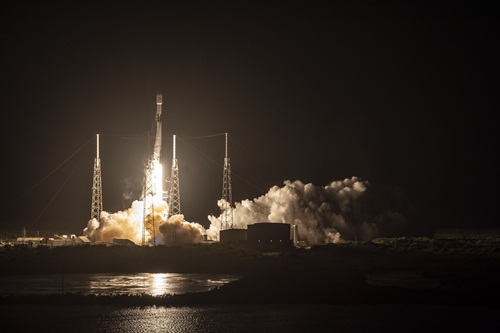Billionaire Elon Musk’s private spacefaring venture SpaceX on Thursday launched 60 `Starlink’ satellites capable of connecting the globe, especially reaching those who are not yet connected, with reliable and affordable broadband internet services.
SpaceX used a Falcon 9 heavy lift rocket to deploy the 60 satellites, each weighing 227 kg, ie, a total payload of 13,620 kg.
The Falcon 9 rocket blasted off from Cape Canaveral in Florida around 10:30pm on Thursday (0230 GMT Friday). An hour later, the rocket began to release the satellites at an altitude of 450 kilometres.
The satellites then used their thrusters to take up their positions in a relatively low orbit of 550 kilometres. The final orbit will be decided by SpaceX team.
"Successful deployment of 60 Starlink satellites confirmed!", the company said on its official Twitter account.
Falcon 9’s first stage for this mission previously supported the Telstar 18 VANTAGE mission in September 2018 and the Iridium-8 mission in January 2019. Following stage separation, Falcon 9’s first stage landed on the “Of Course I Still Love You” droneship, which was stationed in the Atlantic Ocean.
“SpaceX designed Starlink to connect end users with low latency, high bandwidth broadband services by providing continual coverage around the world using a network of thousands of satellites in low Earth orbit,” the company said.
As such, Starlink’s simplified design is significantly more scalable and capable than its first experimental iteration.
With the launch of the first 60 Starlink satellites for the `Startup OneWeb’ mission, Musk's firm is now leading the private space race to seize a chunk of the future space internet market.
"All 60 Starlink satellites online, solar array deployment coming up soon," Musk tweeted after the disbursement.
Startup OneWeb is now well ahead of Amazon's Project Kuiper, the brainchild of Musk's space rival Jeff Bezos.
“With a flat-panel design featuring multiple high-throughput antennas and a single solar array, each Starlink satellite weighs approximately 227kg, allowing SpaceX to maximise mass production and take full advantage of Falcon 9’s launch capabilities. To adjust position on orbit, maintain intended altitude, and deorbit,” SpaceX said.
Starlink satellites feature Hall thrusters powered by krypton. Designed and built upon the heritage of Dragon, each spacecraft is equipped with a star tracker navigation system that allows SpaceX to point the satellites with precision. Importantly, Starlink satellites are capable of tracking on-orbit debris and autonomously avoiding collision. Additionally, 95 per cent of all components of this design will quickly burn in Earth’s atmosphere at the end of each satellite’s lifecycle — exceeding all current safety standards — with future iterative designs moving to complete disintegration, says the company.
Starlink will become operational once 800 satellites have been activated, which will require a dozen more launches.
This mission will push the operational capabilities of the satellites to the limit. SpaceX expects to face issues along the way, but learn from these and develop an affordable and reliable broadband service in the future.






















